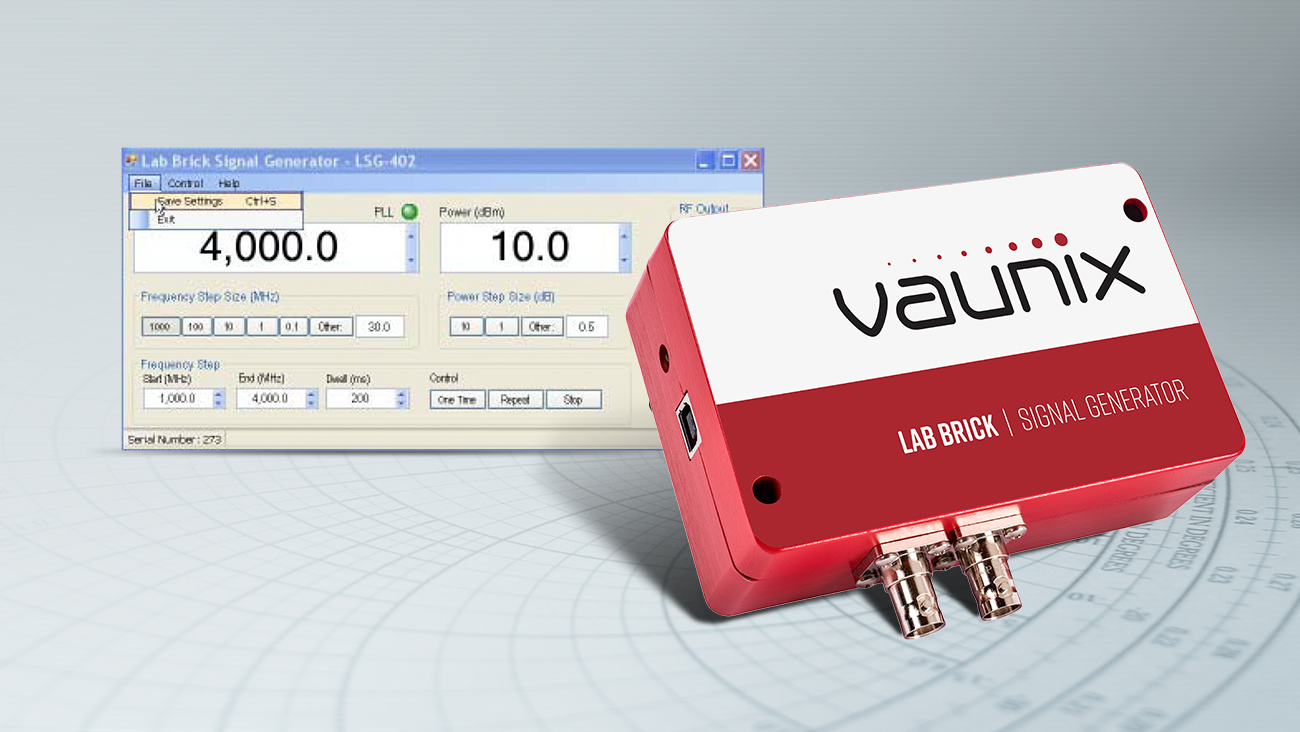Programming Lab Brick Portable RF Signal Generators

As instruments, rather than components like attenuators and phase shifters, signal generators are more complicated to set up. But our goal has been to make the Lab Brick LSG and LMS Series instruments portable and easy-to-use, while remaining extremely capable.
Getting Started
Signal frequency, frequency/power step size, as well as pulse and sweep modes are all configured in the same screen. The frequency-setting field is on the left and you just type in your desired frequency into the window and hit the “Enter” key. The PLL indicator in the window will turn green to verify that the frequency is established. You can also use the up/down arrows.
Step Size and Sweep Mode
Below this is where you set the desired step size and we give you some presets: 100 kHz and 1, 10, and 100 MHz. Select “Other” and you can enter any step size between 100 Hz and 1000 MHz. The signal generators can be configured to linearly sweep through a range of frequencies, and setting this up is simple. Enter the start and end frequencies and sweep time. (You can’t make a mistake because minimum start and end frequency limits are specific to the Lab Brick signal generator you’re using. The sweep time can be set from 1 ms to 1000 s).
The software will sweep once if you select “One Time” and “Stop” disables the sweep. Select “Repeat” and the signal generator will repeatedly sweep from the start to end frequency, blank the retrace, and begin the sweep again at the start frequency. You can also perform a “bidirectional sweep” by checking the box enabling this function. In a bidirectional sweep the signal generator sweeps from the start frequency to the end frequency and back again. Sweep time is the time is takes to go from start to stop frequencies so the full cycle from the start frequency back to the start frequency is twice the specified sweep time.
RF Output Power
On the same screen, you also set the RF output power by typing the desired output power into the window or via the up/down arrows as shown below. Next to this on the screen is the step size with presets of 1 and 10 dB. Select “Other” and you can choose any step size between 0.5 and 40 dB in 0.5 dB increments.
NOTE: After setting frequency and power, you can save the current settings in the device from the File menu at the top of the screen, so the next time you power-up the signal generator this state will be recalled. One of the useful functions in our software is the ability to allow the Lab Brick generators to operate from a USB power source (a USB hub) even if they’re not connected to a computer. Once you’ve configured the generator and saved the setting, remove the power by unplugging the instrument from the USB hub. When power is again applied whether from USB hub or USB battery pack, the instrument will operate at the saved setting.
Synchronizing with an External Clock
There may be times when you’ll want to synchronize the Lab Brick from an external 10-MHz clock reference. To do that, connect the source to the BNC connectors on the instruments and select External Reference from the Control menu. The display will show a check mark next to External Reference command. You can also toggle between reference sources using the F3 key on the keyboard.
Pulse Modulation
Lab Brick Signal Generators can generate pulse modulation, which you enable and configure from Pulse Mode, which lets you control pulse width and pulse repetition interval. The minimum pulse width is 100 ns and minimum pulse repetition rate is equal to the pulse width plus 100 ns. An external pulse trigger can be enabled via a BNC connector on the Lab Brick. Similarly, external pulse modulation can be applied from another BNC connector.
Frequency Sweep Triggering
An optional feature of the generators is a frequency sweep trigger, which lets you control the start time of the linear frequency sweep via a TTL control signal on Sweep Trigger Input BNC connector.
Download Lab Brick software on our software page and learn more about using Lab Bricks from our FAQs.
Stay tuned for our next blog covering Vaunix's Phase Shifters.
And contact our technical support team with any questions regarding your Lab Brick Signal Generators.



